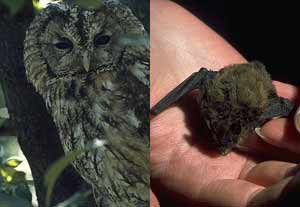Habitats change every day, and sometimes more frequently than this! Most habitats are light during the day and dark at night (with the exceptions of those underground, or in the depths of the oceans). Different groups of organisms may use a particular habitat during the hours of darkness, while those active during the day are asleep. These 'nocturnal' organisms have some distinct adaptations, for example they often have larger, more sensitive eyes and excellent hearing. Others may have very poor eyesight, like bats, but have an echo-location system of high-pitched squeaks which helps them navigate and find food.
|
|

The tawny owl has large, sensitive eyes to help it see its prey, whilst bats have large ears for using echo-location. Both are adapted for a nocturnal habitat.
|

![[Advert]](../../images/ad/content.gif)

![[Advert]](../../images/ad/content.gif)